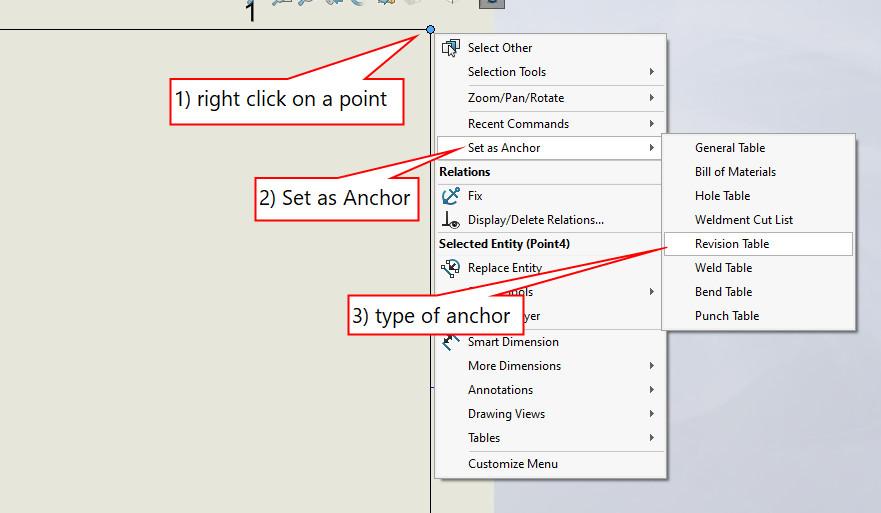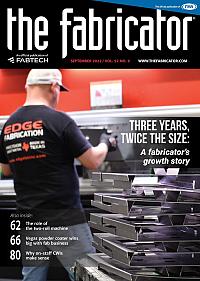Contributing Writer
- FMA
- The Fabricator
- FABTECH
- Canadian Metalworking
Categories
- Additive Manufacturing
- Aluminum Welding
- Arc Welding
- Assembly and Joining
- Automation and Robotics
- Bending and Forming
- Consumables
- Cutting and Weld Prep
- Electric Vehicles
- En Español
- Finishing
- Hydroforming
- Laser Cutting
- Laser Welding
- Machining
- Manufacturing Software
- Materials Handling
- Metals/Materials
- Oxyfuel Cutting
- Plasma Cutting
- Power Tools
- Punching and Other Holemaking
- Roll Forming
- Safety
- Sawing
- Shearing
- Shop Management
- Testing and Measuring
- Tube and Pipe Fabrication
- Tube and Pipe Production
- Waterjet Cutting
Industry Directory
Webcasts
Podcasts
FAB 40
Advertise
Subscribe
Account Login
Search
Everything fabricators need to know about anchor points in CAD tables
Know where the tables will show up in the sheet formats
- By Gerald Davis
- September 23, 2022
- Article
- Manufacturing Software

FIGURE 1A. Here’s how to position an anchor point for a revision table when editing a sheet format: Right-click on a point, select Set as Anchor, and select Revision Table as the type of anchor.
Terms in italics indicate terminology in the brand of mainstream 3D CAD being used for this presentation. The design of a drawing’s sheet format includes decisions regarding the anchor points that control the locations for various tables that may appear on the drawing. As an example scenario, a goal for the revision table could be to always have it appear in the upper right corner of drawings.
An anchor point in the sheet format controls the default position of a table. It prevents the table from accidentally being moved by the mouse. An anchor point also serves as a snap point during the drag-and-drop of tables onto a drawing.
In terms of CAD operation, the design of drawing templates and drawings for production share a fortunate overlap—the same CAD skills are needed to create each. In terms of what detail is to be included, templates are sparse compared to a production drawing.
For example, a revision table template will just have headings in the template, no rows. In contrast, a revision table in a production drawing is likely to have one or more rows of information.
Save early, save often, and test the progress: As the design of the template progresses, a table may be saved as a table template with a right-click, then save as template. That table template then can be inserted into other drawings or templates. The same can be done for a sheet format.
Half the Victory Is Aim
To add an anchor point for a table to the sheet format’s design:
- Edit the sheet format.
- Identify a point on the border as the desired anchor point.
- Right click on that point to summon a pop-up menu (see Figure 1A).
- From the list, select Set as Anchor.
- Select the type of anchor that matches the type of table that will anchor to it.
Anchor points can’t be deleted. They are merely relocated or ignored. Unless someone pays attention to locating anchor points, the various types are likely to default to the same (probably not very useful) location.
Half the Victory Is Readiness
Having an anchor point properly located in the sheet format is only half the battle. The table itself must know how to attach to the anchor point in the sheet format.
Figure 1B shows the revision table’s property manager on the left and the table itself on the right. To set up a table for use with an anchor point:
- Select the table.
- In the table’s property manager, select the favorite corner for anchoring.
- Check the box to enable the table to attach to the anchor point (see Figure 1C).
Here’s a CAD tip: If there is a table that won’t move because it is anchored, uncheck the box to alter the table’s anchoring behavior. Using Figure 1D as an example, this hole table might not need an anchor point, so we’ll disable its anchoring and drag it to a good location.

FIGURE 1B. Here’s how to set table position preferences to work with anchor points in a sheet format: Select the table, select the corner to use, and check the box.
Here’s a side note: The property manager for the table offers several options, depending upon the type of table. All tables have settings for their anchor point. The use of the zone column in the revision table (to hint at where to look for changes on the drawing) was discussed in the July 2022 episode of this column.
The setup of anchoring for any table follows the same process: Set the anchor point in the sheet format and set the table positioning properties for the table.
The victory is performance.
About the Author
subscribe now

The Fabricator is North America's leading magazine for the metal forming and fabricating industry. The magazine delivers the news, technical articles, and case histories that enable fabricators to do their jobs more efficiently. The Fabricator has served the industry since 1970.
start your free subscription- Stay connected from anywhere

Easily access valuable industry resources now with full access to the digital edition of The Fabricator.

Easily access valuable industry resources now with full access to the digital edition of The Welder.

Easily access valuable industry resources now with full access to the digital edition of The Tube and Pipe Journal.
- Podcasting
- Podcast:
- The Fabricator Podcast
- Published:
- 04/16/2024
- Running Time:
- 63:29
In this episode of The Fabricator Podcast, Caleb Chamberlain, co-founder and CEO of OSH Cut, discusses his company’s...
- Industry Events
16th Annual Safety Conference
- April 30 - May 1, 2024
- Elgin,
Pipe and Tube Conference
- May 21 - 22, 2024
- Omaha, NE
World-Class Roll Forming Workshop
- June 5 - 6, 2024
- Louisville, KY
Advanced Laser Application Workshop
- June 25 - 27, 2024
- Novi, MI

































